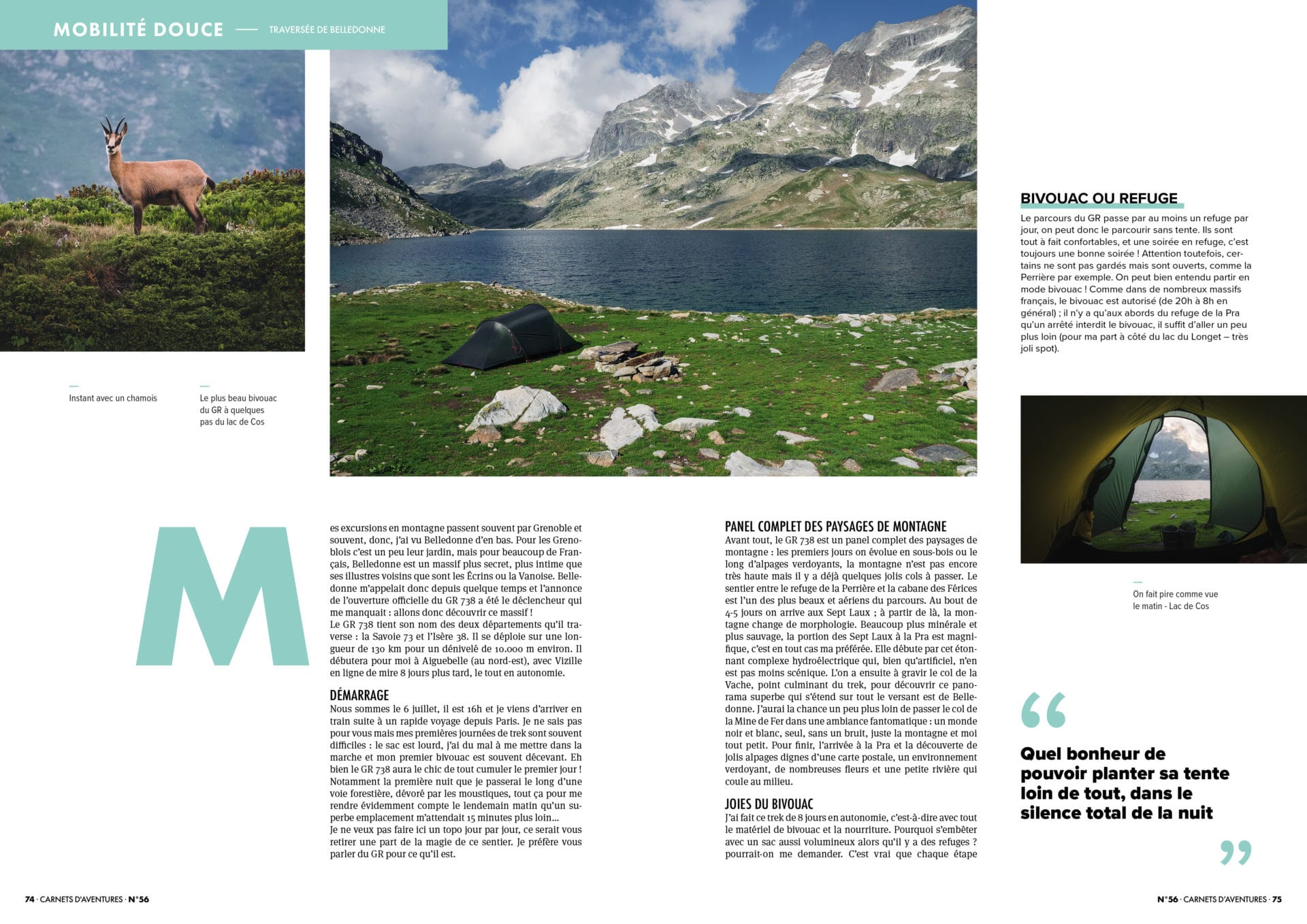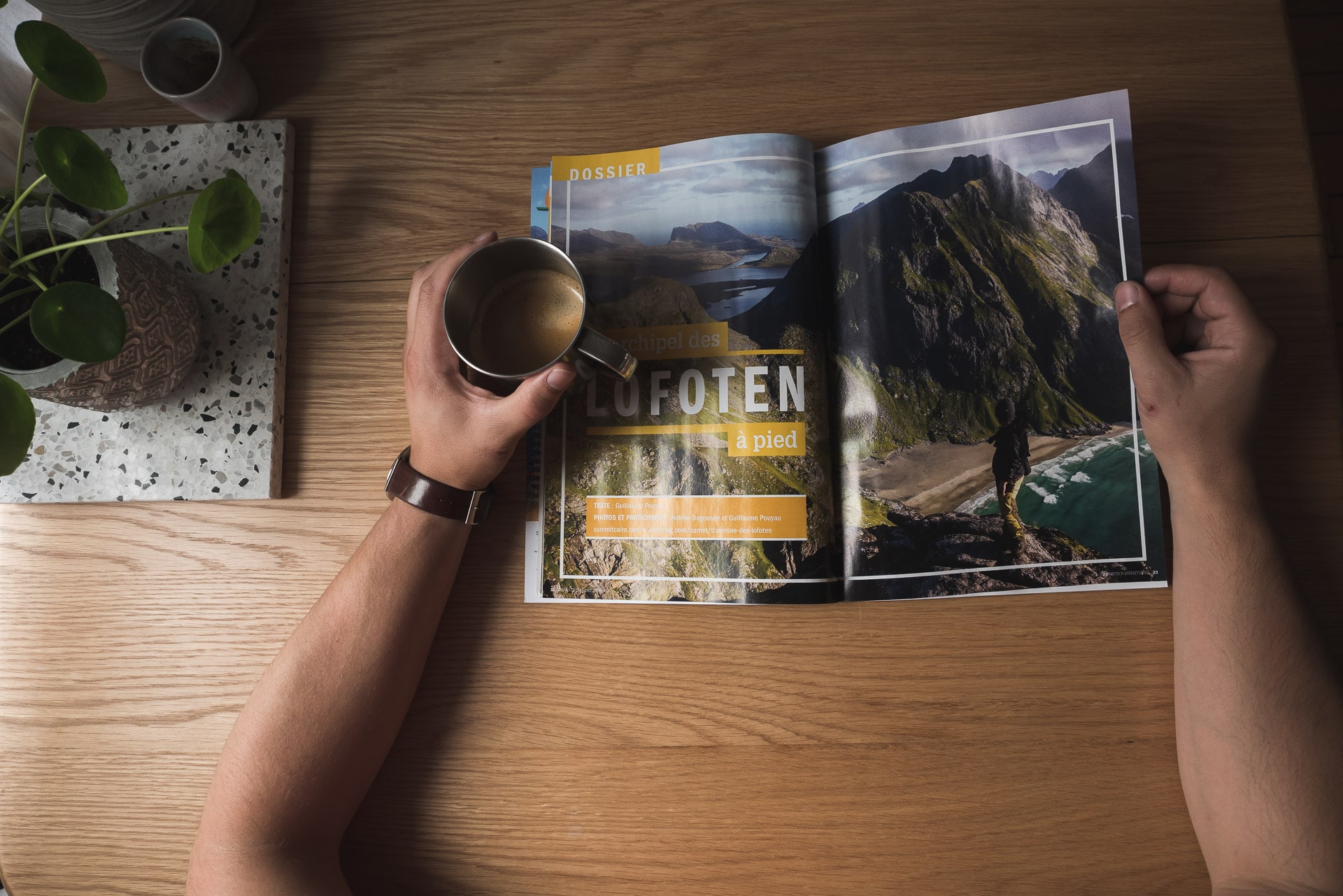Carnet Diem 'La Solitude' avec Carnets d'Aventures
Following our previous collaboration, Carnets d’Aventures asked me to write one page per issue to link a reflection around homelessness, adventure with a literary or other work. This first publication has the theme loneliness and is based on an extract from Pete Fromm’s Indian Creek, a description of which can be found here.
Thanks to Carnets d’Aventures for their trust.
You can also find the number 57 of Carnets d’Aventures at the following address.
Soft mobility with Carnets d'Aventures
The number 56 of Carnets d’Aventures was once again the occasion to offer one of my trek accounts. In this case the crossing of Belledonne along the GR738 carried out during the summer of 2018. The publication is part of the “Change of approach” contest of the Mountain Wilderness association which I won the “Bivouac” prize “. I let you discover the story and also the reflection on soft mobility in general.
You’ve probably heard of the Changer d’Approche competition organized by Mountain Wilderness (changerdapproche.org). This approach promotes mountain outings with access by public transport. Carnets d’Aventures is a partner in the competition and we are awarding a special bivouac prize. For the 10th edition, it is Guillaume Pouyau the winner with his crossing of the Belledonne massif on foot, and access by train + bus from Paris. A good reason to publish his story (page 72) which inaugurates a new section “Soft mobility” with which we want to encourage even more the use of “soft” transport to go and make beautiful itineraries without motor! Guillaume practices the bivouac trek almost everywhere in Europe; whether in France or abroad, on a daily basis or for his trips, he uses soft mobility and promotes it. We evoke together this sympathetic and elegant concept!
A significant part of our greenhouse gas emissions comes from transport (~ 40% in France), in particular road and air transport. Faced with the paradigm of “all cars”, the concept of soft mobility, eco-mobility or sustainable mobility, brings together “modes of transport deemed less harmful to the environment, safe and sober, in particular with a lower contribution to gas emissions greenhouse ”(Wikipedia).
Soft mobility offers an eco-responsible alternative both during our daily trips and our trips. It is this last point that we address more specifically in this article, but keep in mind that it is all of our actions that will make a difference on climate health. By soft mobility, we mean non-motorized means (walking, cycling, kayaking …) as well as the train and more generally surface public transport as these are relevant alternatives to reduce the overall impact of our trips.
Let’s start from two examples:
Paris – Grenoble: 575 km by road. By car, this trip will take you 5:20, consume 30L of fuel and release about 100 kg of CO2 (for a recent car), so let’s say 50 kg per passenger because it is always more pleasant to travel as a couple. Let’s go now by train, we will arrive in 3 hours, during which we will have read adventures, we will have virtually consumed 0L of oil and the CO2 emissions will be around 2 kg per passenger …
A return flight from Paris to Buenos Aires will emit 4 tonnes of CO2 per passenger, enough to double its annual carbon footprint. The figures speak for themselves… We are more and more eco-responsible in our daily actions, but when it comes to our holidays, we often tend to forget these good resolutions and to underestimate (out of ignorance?) the real impact of our actions (“I make efforts all year, so it’s not annoying if I fly for my vacation” without taking into account that it can double my annual carbon footprint) . It is true that soft mobility imposes some constraints, in particular in public transport, such as precise timetables, sometimes connections to manage, and potentially the cost which can be higher per person (this is the case in our example Paris – Grenoble). But let us rather ask ourselves why favor soft mobility, we see here three relevant reasons:
Accessibility: let’s start from the observation that in France the rail network is particularly well developed and areas, even remote, are accessible by train or public transport. In addition, there are now 20,000 km of cycle route just in France. Solutions already exist but it is obviously necessary to develop and promote a coherent policy with the aim of offering users an eco-responsible alternative to the car (for example, not eliminating night trains, or offering reliable alternatives), in particular for journeys Daily. Similarly for journeys in Europe, soft mobility is a good alternative to the car or plane. On a trip I was able to make to Lapland, the train from Oslo was more interesting than the “all plane” if we took into account the whole timetable and the associated costs.
Eco-responsibility: the main reason for choosing soft mobility is obviously environmental. Traveling by bicycle has an impact that is in no way comparable to that of a trip, even a short one, by car. Here again, often through ignorance of the orders of magnitude of the impact of our actions, we can notice “inconsistencies” in our behavior: for example, we find that throwing the garbage from your picnic in the mountains would not come to idea of (almost) anyone and is overwhelmingly considered ecologically shocking, so taking the car daily for short trips that would be easily doable otherwise is in the habit.
GR738 with Carnets d'Aventures
Issue 56 of Carnets d’Aventures was once again an opportunity to work with this great magazine. In this case to share my crossing of Belledonne along the GR738 carried out during the summer of 2018. The publication is part of the “Change of approach” contest of the Mountain Wilderness association which I had won the price “Bivouac” in 2018. I let you discover the story and also the reflection on soft mobility in general.
You can also find the number 56 of Carnets d’Aventures at the following address.
Lofoten islands with Carnets d'Aventures
On the occasion of issue 53 of Carnets d’Aventures, we had the chance, with Hélène, to be able to share our experience in the Lofoten Islands. You can obviously find the original story by following this link, but you can also order Carnets d’Aventures 53 directly from the magazine’s website. I can only advise you to read it too much, which will be a source of inspiration, material tests, good advice, …
Bivouac Guide avec Les Others
Discover the “Petit Guide du bivouac” that we wrote with Les Others. 5 tips to make the bivouac accessible to everyone and discover the joys of sleeping in the heart of Nature.
Visit the Les Others website: https://www.lesothers.com/petit-guide-bivouac/
Also take the opportunity to discover the other beautiful stories offered by the site.












